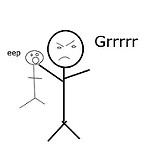The bedraggled use “restorative bullying” to bolster their sagging self-image – attempting to “even the scales” through targeting individuals even lower on the office totem pole. They look for employees not sturdy enough to withstand verbal pummelings – individuals who appear cast down, demure, shamefaced, self-effacing, conciliatory, and downtrodden. Sacrificial offerings on whom to cast the group’s collective sin, persons expected to “take one for the team” to relieve tensions.
Sapolsky (2017), in his book Behave, refers to “third-party” or “displacement” aggression. He argues that sentient beings behave aggressively to reduce stress, with glucocorticoid levels declining after one bites, kicks, verbally abuses, or physically assaults someone else. In animal kingdoms, omegas play the role of institutional scapegoat. In families, children and spouses become fodder for breadwinner retorts; while in firms, anyone considered “different” and therefore “lesser than” may experience an inordinate level of abuse. Dishing it out may thus prevent one from feeling a willingness to “take it.” The more stressed people feel (as one would expect in toxic workplace cultures), the less empathy they display, and the more egocentric they become (Sapolsky, 2017). Even more shocking is that individuals who engage in “appetitive aggression,” or abuse for the mere “pleasure” of the act, are less susceptible to mental illness (Elbert, Moran, and Schauer, 2017).
Some people may be more predisposed to “restorative bullying” than others. According to Paulhus and Jones (2017), Machiavellians (characterized by “manipulative tendencies,” “callous affect,” and “strategic inhibition,”) display aggression in what they perceive as “consequence free” social or workplace cultures. Schoolyards and organizations without rules thus proliferate piranha type barbs, in which persons willing to take a bite out of their coworkers run amuck.
Lack of effort creates firms without consequence. Laissez-faire (at work) occurs in the following ways:
Letting abusers steal the organizational show. Third party aggression is exacerbated when we categorize people into “ingroup,” and “outgroup” designations; what Sapolsky terms “Us versus Them.” Dominant parties may therefore reify their position through outgroup denigration – e.g., making gratuitous potshots, interrupting a speaker, and/or insulting their platforms. Leaders who make flippant remarks (and do nothing) reinforce a vicious cycle of results. A desire to be part of the “ingroup” may (in toxic firms) supersede the need to act decent.
Pretending abusers are correct. Willingness to be on the “winning” team, combined with attraction for “strong” supervisory management may result in team members rallying around abusive types, subsequently recategorizing targets as “weak,” “vulnerable,” and socially inept. No one wants to be on the receiving of a bruiser’s tirade, or to be relegated to refugee status – so bystanders keep their mouths shut.
Acting as if abuse did not occur. Business as usual following office savagery sends a message that “delinquency is welcome here.” Probationary members follow suit, using the target roadmap provided by senior management.
The bottom line is that someone at work needs to take responsibility for crafting policy, calling abusers on the carpet, and promoting a bully free culture. The fact that 27 percent of surveyed workers reported workplace abuse is testament to the profound nature of this problem (Namie, 2014).
References
___________________________________________________________________________________
Elbert, T., Moran, J., & Schauer, M. (2017). Appetitive aggression. In Bushman, B. J. (Ed.), Aggression and Violence: A Social Psychological Perspective. New York, NY: Routledge.
Namie, G. (2014). 2014 U.S. Workplace Bullying Survey. Retrieved from http://workplacebullying.org/multi/pdf/WBI-2014-US-Survey.pdf
Paulhus,D. L., & Jones, D. N. (2017). Individual differences in aggression: The role of dark personalities. In Bushman, B. J. (Ed.), Aggression and Violence: A Social Psychological Perspective. New York, NY: Routledge.
The real reason highly sensitive people get bullied





Recent Comments